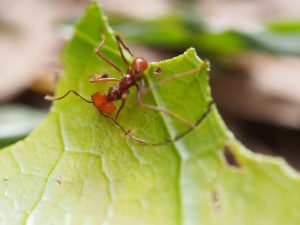I wake up in the middle of the night and step outside to something I have never felt before. It is the rainforest night. The air is rich with animal sounds. The sky is pitch black but adorned with countless stars, creating the illusion of a deep indigo-gray. Heartbeats of lighting illuminate the sky, but there is no rain. An unmatched sense of awe comes over me, something I could only feel being alone before nature’s grandeur.
Many hours later, my class and I are in the forest. Tall kapok trees (Ceiba pentandra) along the path form islets of intense shade, and yellow prickly trees (Zanthozylum spp.) sporadically flank the path with yellow-brown adornments. Some of the yellow prickly plants were speckled with tiny crawling ants. These leaf-cutter ants chisel and delivery circular sheets of leafs to their colonies, advanced eusocial communities that mature over time.
We say three ant colonies: one year old, four years old, and ten years old. Similar to an individual organism, the colonies aged, growing larger and more advanced with time. Leaf-cutter ants sustain by cultivating fungus on leaf pieces concealed in underground chambers, and thus colonies must have increasing number of chambers to grow enough food to feed their growing numbers. With time, colonies supported more types of workers and had longer, deeper, and wider tunnels.

Late in the afternoon, I saw five scarlet macaws (Ara macao) fly across the sky in unison. Although macaws lack a complex social structure like leaf-cutter ants, they still cluster for social interaction and increased protection from predators.
It is interesting how human social interactions relate to those of other organisms. Some people have clearly defined senses of duty, like worker ants chiseling leaves for their colonies. Some exhibit altruism, like a scarlet macaw rearing her chicks. Even if there is no evolutionary relationship between the social interactions of humans and other animals, it is interesting to see the common elements.
However, sometimes it’s preferred to forgo my social role and be alone. The sky is much more powerful that way.

